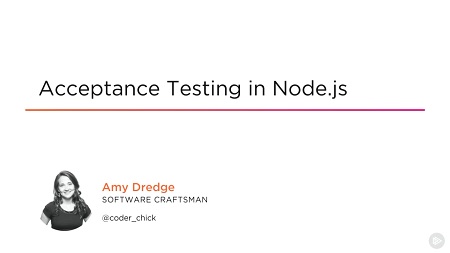
English | MP4 | AVC 1280×720 | AAC 44KHz 2ch | 3h 19m | 513 MB
This course will teach you about acceptance tests – tests which enter just beneath the UI and enable you to increase the quality of your code, improve your development process, and deliver customer value.
UI tests are comprehensive, but they are also brittle. Unit tests are reliable, but they don’t test interactions between units. Acceptance tests help fill the need for testing user scenarios without the brittleness of UI tests. In this course, Acceptance Testing in Node.js, you will learn the what, why, and how of acceptance tests. First, you will learn what acceptance tests are and why you should write them. Next, you will explore how to write acceptance tests for existing code, including using SuperTest. Finally, you will see how to use acceptance tests to drive your code with acceptance test driven development. When you’re finished with this course, you will have the skills and knowledge of acceptance testing needed to increase the quality of your code, improve your development process, and deliver customer value.
Table of Contents
01 – Course Overview
02 – Introduction
03 – Automated Tests
04 – Types of Automated Tests
05 – What Is Acceptance Testing
06 – Interpretations of Acceptance Tests
07 – Why Should You Write Acceptance Tests
08 – Summary
09 – Introduction
10 – How to Write an Acceptance Test
11 – Arrange, Act, Assert
12 – Red, Green, Refactor
13 – Acceptance Test Driven Development (ATDD)
14 – How Many Acceptance Tests Should You Write
15 – Acceptance Tests and Continuous Integration
16 – Summary
17 – Introduction
18 – Prerequisites
19 – Demo Application
20 – Installing Git and Node
21 – Installing MongoDB
22 – Get the Code and Run the App
23 – Familiarize Yourself with the Code – App Startup and Routing
24 – Familiarize Yourself with the Code – Business Logic and Data Access Layers
25 – Familiarize Yourself with the Code – Integration Tests
26 – Familiarize Yourself with the Code – Unit Tests
27 – Summary
28 – Introduction
29 – First Acceptance Test
30 – Start Test Instance Automatically
31 – Acceptance Test to Catch a Bug – Extract GET Helper
32 – Acceptance Test to Catch a Bug – Extract POST and DELETE Helpers
33 – Acceptance Test to Catch a Bug – Failing Acceptance Test
34 – Acceptance Test to Catch a Bug – Fix Bug and Passing Acceptance Test
35 – Refactor Acceptance Test
36 – Summary
37 – Introduction
38 – What Is SuperTest
39 – SuperTest – Setup
40 – SuperTest – API Calls
41 – SuperTest – Assertions with .expect()
42 – SuperTest – Assertions with .then() or .end()
43 – Demo – Refactor First Test to SuperTest
44 – Demo – Different Structure for First Test
45 – Demo – Refactor Second Test Block to SuperTest
46 – Demo – Test Cleanup with SuperTest
47 – SuperTest vs. Hand Rolled
48 – Summary
49 – Introduction
50 – Failing Acceptance Test – Two Lists with Names
51 – Passing Acceptance Test – Two Lists with Names
52 – When Can You Ship
53 – Failing Acceptance Test – Getting a List by Id
54 – Passing Acceptance Test – Getting a List by Id
55 – Acceptance Test – Getting All Lists for a User
56 – Make UI Changes to Support Multiple To Do Lists
57 – Retrospect
58 – Summary
Resolve the captcha to access the links!